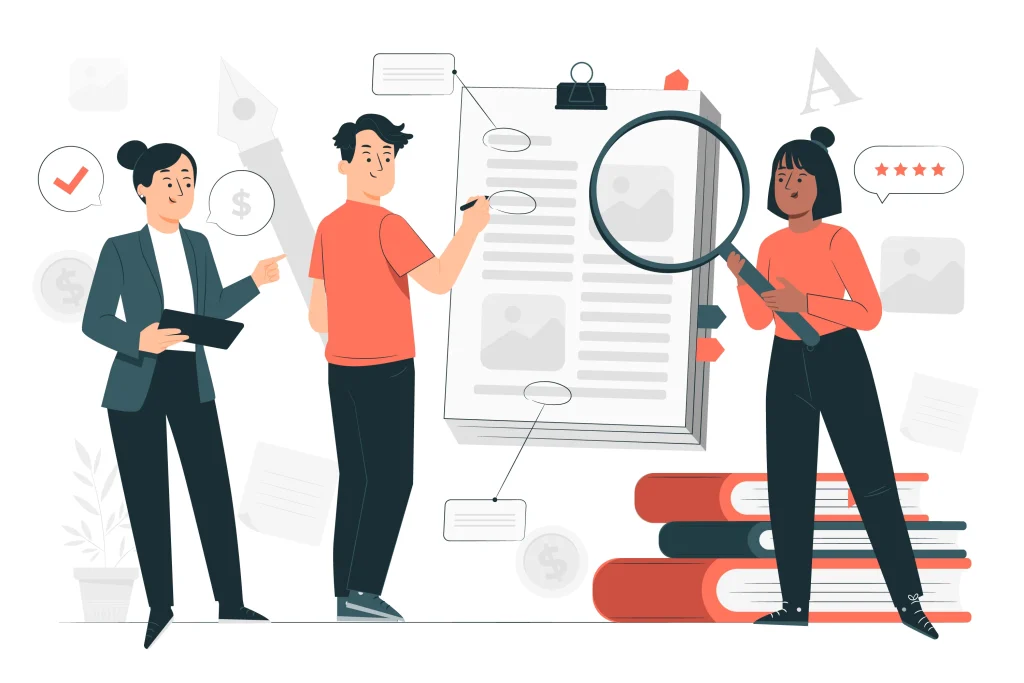
In the rapidly evolving landscape of contemporary business, the effective development of teams has emerged as a pivotal factor for achieving outstanding results. From setting clear objectives to fostering seamless collaboration among team members, team formation and development play a critical role in realizing organizational goals. However, various common mistakes can hinder this journey toward excellence. Recognizing and addressing these pitfalls is essential for steering teams toward success and maximizing their potential. In this article, we will explore ten prevalent team development mistakes and outline strategies to avoid them, ensuring a smoother path toward creating high-performing teams.
Lack of Clear Goals and Objectives
One common mistake in team development is the absence of clear and specific goals. Teams need a clear roadmap to direct their efforts; without one, they might work towards conflicting objectives or lose focus. To address this, set well-defined goals and communicate them regularly to the team.
Consequences of this Mistake:
- Confusion: Without clearly defined goals, team members may be unclear about priorities and the desired outcomes of their efforts.
- Misalignment: Team members might pursue conflicting objectives or, worse, engage in tasks that do not contribute to the organization’s overall success.
- Lack of Motivation: Clear goals provide a sense of purpose and motivation. Without them, team members may feel aimless and demotivated.
How to Avoid:
- Establish SMART Goals:
- Specific: Clearly define the objectives in specific terms.
- Measurable: Set criteria to measure progress and success.
- Achievable: Ensure that goals are realistic and attainable.
- Relevant: Align goals with the overall mission and strategy.
- Time-Bound: Set deadlines to create a sense of urgency.
- Communication is Key:
- Regularly communicate goals to the entire team.
- Ensure that everyone understands their role in achieving these goals.
- Use various communication channels to reinforce the importance of objectives.
- Regular Goal Reviews:
- Periodically review and, if necessary, adjust goals based on changing circumstances.
- Solicit feedback from team members to ensure ongoing relevance.
- Alignment of Tasks:
- Ensure that individual tasks and projects are aligned with the overarching goals.
- Communicate how each team member’s work contributes to achieving larger objectives.
- Encourage Ownership:
- Foster a sense of ownership by involving team members in the goal-setting process.
- Empower individuals to take responsibility for their assigned tasks and contribute proactively.
- Visual Aids and Progress Tracking:
- Use visual aids such as charts or dashboards to represent progress towards goals.
- Regularly update the team on achievements and milestones to maintain motivation.
- Feedback Mechanisms:
- Establish feedback mechanisms to assess the team’s performance against set goals.
- Encourage team members to provide input on the effectiveness of current objectives and suggest improvements.
While some team members focus on increasing social media engagement, others prioritize lead generation. Without alignment, the team might not achieve the overarching goal of boosting brand awareness. The team can work cohesively towards a shared objective by establishing SMART goals, communicating them effectively, and aligning individual tasks.
By addressing the Lack of Clear Goals and Objectives, teams can set a solid foundation for success, ensuring everyone is moving in the same direction with a clear understanding of their roles and the desired outcomes.

Ineffective Communication
Communication breakdowns can cripple team dynamics. Effective communication is key to a successful team, whether it’s poor information flow, unclear messages, or inadequate feedback. Encourage open communication channels, conduct regular team meetings, and leverage collaborative tools to enhance information sharing.
Consequences of this Mistake:
- Misunderstandings: Ambiguities or unclear communication can result in misinterpretations of tasks, goals, or expectations.
- Missed Deadlines: Inadequate communication can lead to missed deadlines, as team members might lack a clear understanding of project timelines or priorities.
- Reduced Collaboration: A lack of transparent communication can hinder collaboration, leading to silos and fragmented efforts within the team.
How to Avoid:
- Open and Honest Communication:
- Encourage a culture of openness and honesty within the team.
- Create an environment where team members feel comfortable expressing their thoughts, concerns, and ideas.
- Clear Messaging:
- Ensure that messages are clear, concise, and easily understandable.
- Avoid jargon or technical language that may confuse team members.
- Use Diverse Communication Channels:
- Use various communication channels (such as email, messaging apps, and video conferencing) to accommodate different preferences and needs.
- Choose the appropriate channel based on the urgency and nature of the communication.
- Regular Team Meetings:
- Schedule regular team meetings to discuss progress, challenges, and upcoming tasks.
- Provide a platform for team members to share updates and ask questions.
- Feedback Mechanisms:
- Establish feedback mechanisms to ensure that messages are received and understood.
- Encourage team members to ask for clarification when needed.
- Transparency:
- Foster a culture of transparency by sharing relevant information with the entire team.
- Keep team members informed about organizational changes, project updates, and other relevant developments.
- Active Listening:
- Emphasize the importance of active listening within the team.
- Ensure that team members are not only expressing their thoughts but also truly understanding each other.
- Document Important Information:
- Document important decisions, action items, and project details.
- Use collaborative tools and platforms to store and share information.
- Clarify Expectations:
- Communicate expectations regarding roles, responsibilities, and deadlines.
- Confirm understanding by asking team members to summarize key points.
Ineffective communication may lead to misunderstandings about the priority of certain features, resulting in delays and frustration. By fostering open communication, holding regular stand-up meetings, and using collaborative tools, the team can ensure everyone is on the same page and working towards the same goals.
Addressing Ineffective Communication is crucial for building trust, fostering collaboration, and creating a positive team environment where ideas flow freely, and tasks are executed precisely.

Ignoring Team Dynamics
Understanding and managing team dynamics is crucial for success. Ignoring conflicts, power struggles, or personality clashes can lead to a toxic work environment. Foster a culture of open dialogue, address conflicts promptly, and promote team-building activities to strengthen interpersonal relationships.
Consequences of this Mistake:
- Conflict Escalation: Ignoring conflicts allows them to fester and escalate, potentially leading to a breakdown in communication and collaboration.
- Decreased Morale: Unresolved issues within the team can lead to decreased morale and negatively affect both individual and collective motivation.
- Reduced Productivity: A toxic work environment can impede productivity, as team members may focus more on interpersonal issues than on their tasks.
How to Avoid:
- Promote Team-Building Activities:
- Organize team-building activities to strengthen relationships and foster a sense of camaraderie.
- These activities can include workshops, retreats, or even simple team lunches.
- Open Dialogue:
- Encourage open dialogue within the team by providing a platform for team members to express their thoughts, concerns, and ideas.
- Create an environment where constructive feedback is welcomed.
- Conflict Resolution Training:
- Provide training on conflict resolution to equip team members and leaders with the skills needed to address conflicts proactively.
- Establish clear processes for resolving disputes.
- Team Role Clarity:
- Clearly define and communicate the roles and responsibilities of each team member.
- This helps prevent ambiguity and potential clashes over tasks or decision-making authority.
- Inclusive Decision-Making:
- Involve team members in the decision-making process to promote a sense of inclusion and ownership.
- Ensure that everyone’s perspective is considered when making important decisions.
- Regular Check-Ins:
- Conduct regular check-ins to assess team dynamics and identify any emerging issues.
- Address concerns promptly and collaboratively.
- Cultivate a Positive Work Culture:
- Foster a positive work culture that values respect, cooperation, and diversity.
- Recognize and celebrate individual and team achievements.
- Leadership Intervention:
- Leaders should actively monitor team dynamics and intervene when necessary.
- Provide guidance and support to resolve conflicts and maintain a healthy team environment.
- Encourage Empathy:
- Promote empathy among team members, encouraging them to understand and consider each other’s perspectives.
- This can lead to a more compassionate and supportive team culture.
Imagine a marketing team where two members consistently clash over the direction of a campaign. Ignoring these conflicts may lead to decreased collaboration and creativity within the team. By implementing conflict resolution training, fostering open communication, and ensuring that team roles are well-defined, the team can address issues before they escalate.
Addressing Team Dynamics is vital for building a cohesive and high-performing team. By actively managing relationships, resolving conflicts, and fostering a positive team culture, organizations can create an environment where team members can thrive and work collaboratively towards common goals.

Neglecting Individual Strengths
Teams consist of individuals with diverse skills and strengths. Failing to recognize and leverage these individual strengths can lead to inefficiencies. Conduct assessments to identify team members’ strengths and assign tasks accordingly, ensuring a more productive and harmonious work environment.
Consequences of this Mistake:
- Underperformance: Team members may not perform at their full potential if their strengths are overlooked or ignored.
- Lack of Innovation: Ignoring diverse skills can restrict the team’s ability to innovate and develop creative solutions.
- Demotivation: When individuals feel that their strengths are not valued, it can lead to demotivation and decreased morale.
How to Avoid:
- Conduct Strengths Assessments:
- Use assessments or surveys to identify the strengths and skills of each team member.
- Understand their unique contributions and areas of expertise.
- Task Assignments Based on Strengths:
- Assign tasks and projects based on individual strengths.
- Ensure that each team member is working in an area where they can excel.
- Encourage Skills Sharing:
- Foster a culture where team members feel comfortable sharing their skills and knowledge.
- This promotes cross-training and a more well-rounded team.
- Professional Development Opportunities:
- Provide opportunities for professional development that align with individual strengths.
- Invest in training and resources that allow team members to enhance their expertise.
- Recognition and Appreciation:
- Regularly recognize and appreciate the contributions of each team member.
- Highlight how their strengths positively impact the team and the organization.
- Diversity in Teams:
- Assemble teams with a diverse set of skills and strengths.
- This diversity can lead to a broader range of perspectives and ideas.
- Team Collaboration:
- Encourage collaboration within the team, allowing team members to leverage each other’s strengths.
- Promote an environment where individuals can seek help or advice from their colleagues.
- Individualized Feedback:
- Provide personalized feedback that acknowledges and reinforces individual strengths.
- This helps team members understand their value and contribution to the team.
Consider a software development team where one member excels at problem-solving while another has strong communication skills. Neglecting individual strengths might result in the problem-solving expert being underutilized in project discussions and the communication expert not being allowed to lead client interactions. By recognizing and leveraging these strengths, the team can assign tasks that align with each member’s expertise, leading to a more efficient and well-rounded team.
Addressing Neglecting Individual Strengths is essential for building a high-performing team. By understanding and utilizing the diverse strengths of team members, organizations can create an environment where individuals feel valued and motivated and contribute their best to the team’s success.

Micromanagement
Micromanaging team members stifle creativity and erode trust. Allow team members the autonomy to execute their tasks and encourage innovation. Establish clear expectations, provide support, and focus on results rather than controlling every aspect of the process.
Consequences of this Mistake:
- Reduced Autonomy: Team members may feel micromanaged, leading to a lack of autonomy in decision-making and execution.
- Creativity Suppression: Micromanagement stifles creativity, as team members may become reluctant to explore innovative solutions or take risks.
- Decreased Morale: Continuous monitoring and control can result in decreased morale and job satisfaction among team members.
How to Avoid:
- Establish Clear Expectations:
- Communicate expectations and goals to team members.
- Provide a framework for decision-making within established parameters.
- Delegate Responsibilities:
- Delegate tasks and responsibilities to team members based on their skills and expertise.
- Trust team members to take ownership of their assigned tasks.
- Results-Oriented Approach:
- Focus on the results and outcomes rather than micromanaging the process.
- Establish key performance indicators (KPIs) and assess them based on goal achievement.
- Provide Resources and Support:
- Ensure that team members have the necessary resources and support to carry out their tasks.
- Offer guidance and assistance when needed, without taking over the entire process.
- Encourage Innovation:
- Foster a culture that encourages innovation and creative problem-solving.
- Allow room for experimentation and learning from both successes and failures.
- Regular Check-Ins, Not Micromanaging:
- Schedule regular check-ins to discuss progress and challenges.
- Use these check-ins as opportunities for support and guidance, rather than as surveillance.
- Trust and Empower:
- Trust team members to make decisions within their areas of responsibility.
- Empower individuals to take ownership of their work and contribute to the team’s success.
- Effective Communication:
- Maintain open lines of communication.
- Communicate expectations, changes in plans, or any necessary adjustments.
- Professional Development:
- Invest in the professional development of team members to enhance their skills.
- Provide opportunities for training and growth to build competence and confidence.
Imagine a project manager who closely monitors every marketing campaign step, providing detailed instructions on content creation, design choices, and even the wording of social media posts. This micromanagement style can demotivate the creative team and limit the campaign’s effectiveness. The manager can create a more creative and empowered work environment by setting clear expectations, delegating responsibilities, and trusting the team’s expertise.
Addressing Micromanagement is crucial for creating a healthy work environment where team members feel trusted, empowered, and motivated to contribute their best efforts. Leaders can build a more collaborative and high-performing team by focusing on results, providing support, and encouraging autonomy.

Inadequate Training and Development
Teams require ongoing training to stay relevant in a rapidly evolving work environment. Neglecting professional development opportunities can lead to skill gaps and hinder team performance. Invest in training programs and encourage continuous learning to keep the team at the forefront of industry trends.
Consequences of this Mistake:
- Skill Gaps: Team members may lack the necessary skills and knowledge to perform their roles effectively.
- Stagnation: Without continuous learning opportunities, teams may become stagnant, failing to keep up with industry trends and best practices.
- Decreased Job Satisfaction: Employees often value opportunities for professional growth and may become dissatisfied if these opportunities are not provided.
How to Avoid:
- Assess Training Needs:
- Regularly assess the skills and knowledge gaps within the team.
- Identify areas where additional training could enhance individual and collective performance.
- Invest in Relevant Training Programs:
- Provide access to training programs that align with the skills needed for current and future tasks.
- Consider both in-house and external training options to provide a range of learning experiences.
- Encourage Continuous Learning:
- Foster a culture of continuous learning within the organization.
- Encourage team members to seek out learning opportunities and stay informed about industry trends.
- Tailor Training to Individual Needs:
- Recognize that each team member may have different learning preferences and needs.
- Tailor training programs to accommodate various learning styles.
- Mentorship Programs:
- Establish mentorship programs to facilitate knowledge transfer and skill development.
- Pair less experienced team members with seasoned professionals to encourage learning from each other.
- On-the-Job Training:
- Provide opportunities for on-the-job training and practical application of new skills.
- Encourage team members to apply what they’ve learned in real-world scenarios.
- Skill-Building Workshops:
- Conduct skill-building workshops and seminars.
- Bring in experts or industry professionals to share insights and best practices.
- Professional Certifications:
- Support team members in obtaining relevant professional certifications.
- Recognize and reward individuals who enhance their skills through certifications.
- Regular Training Reviews:
- Periodically review the effectiveness of training programs.
- Adjust training strategies based on feedback and changing organizational needs.
The team may struggle to deliver projects efficiently without ongoing training in newer technologies. By investing in training programs covering the latest programming languages and development methodologies, the organization can ensure that the team remains competitive and adapts to technological advancements.
Addressing Inadequate Training and Development is crucial for maintaining a skilled and adaptable workforce. By investing in continuous learning, organizations can empower their teams to stay competitive, innovative, and equipped with the skills to tackle evolving challenges.

Lack of Recognition
Failing to recognize and appreciate team members’ contributions can lead to demotivation and reduced morale. Implement an acknowledgment system, celebrate achievements, and create a positive work culture that values and rewards individual and collective accomplishments.
Lack of recognition occurs when organizations fail to acknowledge and appreciate their team members’ efforts, achievements, and contributions. This mistake can lead to demotivation, decreased morale, and hindered overall team performance.
Consequences of this Mistake:
- Demotivation: Team members may feel unappreciated, leading to a decrease in motivation and engagement.
- Decreased Morale: A lack of recognition can result in lower morale, impacting the overall atmosphere and collaboration within the team.
- Retention Issues: Employees who feel undervalued may seek opportunities elsewhere, leading to retention challenges.
How to Avoid:
- Establish Recognition Programs:
- Implement formal recognition programs that highlight and reward individual and team achievements.
- These programs can include awards, certificates, or public acknowledgments.
- Regularly Acknowledge Contributions:
- Regularly acknowledge and appreciate the contributions of team members.
- Recognize both small and significant achievements to create a positive and inclusive culture.
- Peer Recognition:
- Encourage a culture of peer-to-peer recognition.
- Create mechanisms for team members to acknowledge and celebrate each other’s accomplishments.
- Publicize Successes:
- Publicize team and individual successes within the organization.
- Share success stories through internal communication channels, such as newsletters or company-wide meetings.
- Personalized Recognition:
- Tailor recognition to the individual preferences of team members.
- Some may prefer public acknowledgment, while others may appreciate a private note of appreciation.
- Feedback and Appreciation Sessions:
- Incorporate regular feedback and appreciation sessions into team meetings.
- Allow team members to share their achievements and express gratitude for each other’s efforts.
- Monetary and Non-Monetary Rewards:
- Offer a combination of monetary and non-monetary rewards as a form of recognition.
- Non-monetary rewards can include flexible work hours, professional development opportunities, or involvement in special projects.
- Recognition from Leadership:
- Ensure that leadership actively participates in recognizing and appreciating the efforts of the team.
- Leadership recognition carries significant weight and sets the tone for the entire organization.
- Performance Reviews with Recognition Component:
- Integrate a recognition component into performance reviews.
- Linking recognition to performance reinforces a culture of continuous improvement.
Team members may feel undervalued, impacting their motivation to maintain high performance. By implementing a recognition program that publicly celebrates sales achievements, the organization can boost morale, foster a positive work environment, and potentially improve retention rates.
Addressing the Lack of Recognition is crucial for creating a workplace where team members feel valued and motivated. By implementing consistent and varied recognition strategies, organizations can boost morale, enhance engagement, and cultivate a positive culture of appreciation.

Absence of Regular Feedback
Feedback is essential for growth and improvement. Without regular feedback, team members may not know where they stand or how they can enhance their performance. Establish a feedback loop, encourage constructive criticism, and provide regular evaluations to help the team continuously improve.
Consequences of this Mistake:
- Uncertainty: Team members may feel uncertain about their performance, not knowing whether they are meeting expectations or where they can improve.
- Stagnation: Without regular feedback, individuals may struggle to identify areas for growth, leading to stagnation in their professional development.
- Decreased Morale: The lack of acknowledgment or guidance can result in decreased morale and job satisfaction among team members.
How to Avoid:
- Establish a Feedback Culture:
- Foster a culture where feedback is not only accepted but actively encouraged.
- Create an environment where team members feel comfortable giving and receiving feedback.
- Regular Check-Ins:
- Schedule regular one-on-one check-in meetings between team members and their supervisors.
- Use these sessions to discuss progress, challenges, and goals.
- Timely Recognition and Correction:
- Provide feedback promptly, both for positive contributions and areas that need improvement.
- Timeliness enhances the effectiveness of feedback and allows for prompt course corrections.
- Constructive Criticism:
- Ensure that feedback is constructive and specific, focusing on behaviors and actions rather than personal attributes.
- Guide how individuals can improve and excel in their roles.
- 360-Degree Feedback:
- Implement a 360-degree feedback system that gathers input from peers, subordinates, and supervisors.
- This comprehensive approach provides a holistic view of an individual’s performance.
- Goal Alignment:
- Align feedback with individual and organizational goals.
- Highlight how specific behaviors or achievements contribute to broader objectives.
- Encourage Self-Assessment:
- Encourage team members to assess their own performance.
- This self-reflection can be a valuable tool for personal growth and development.
- Feedback Training:
- Provide training on giving and receiving feedback effectively.
- Equip team members and leaders with the skills needed for constructive communication.
- Use Technology:
- Utilize technology tools for continuous feedback, such as performance management software or digital collaboration platforms.
- These tools can facilitate real-time feedback and documentation.
Consider a marketing team where team members receive feedback only during annual performance reviews. This infrequent feedback can lead to unclear project outcomes and hinder the team’s ability to adapt and improve in real-time. The team can address issues promptly and foster continuous improvement by implementing regular check-ins and project-specific feedback sessions.
Addressing the Absence of Regular Feedback is crucial for creating a culture of continuous improvement and professional development. By providing timely, constructive, and goal-aligned feedback, organizations can empower their teams to excel, adapt to challenges, and contribute more effectively to overall success.

Overlooking Diversity and Inclusion
A diverse team brings a wealth of perspectives and ideas. Ignoring diversity and inclusion can result in a lack of creativity and hinder problem-solving capabilities. Embrace diversity, create an inclusive environment, and foster a culture that values different backgrounds and experiences.
Consequences of this Mistake:
- Limited Perspectives: Lack of diversity leads to a limited range of perspectives and ideas within the team, potentially hindering creativity and problem-solving.
- Employee Disengagement: When employees perceive a lack of inclusivity, it can lead to disengagement, reduced morale, and lower productivity.
- Risk of Discrimination: Failure to address diversity and inclusion can create an environment where discrimination or bias goes unchecked, leading to legal and reputational risks.
How to Avoid:
- Establish Diversity and Inclusion Policies:
- Develop and communicate clear diversity and inclusion policies that outline the organization’s commitment to creating a diverse workplace.
- Ensure that these policies are well-understood and adhered to at all levels.
- Diverse Hiring Practices:
- Implement diverse hiring practices to attract candidates from various backgrounds.
- Consider blind recruitment techniques to minimize unconscious biases in the hiring process.
- Inclusive Leadership:
- Promote inclusive leadership at all levels.
- Leaders should actively encourage and listen to diverse voices, fostering an environment where everyone feels heard and valued.
- Diversity Training:
- Provide diversity and inclusion training for all employees.
- This training should address biases, promote cultural awareness, and highlight the importance of an inclusive workplace.
- Employee Resource Groups:
- Establish employee resource groups or affinity groups to provide a platform for underrepresented employees to connect, share experiences, and contribute ideas.
- Equal Opportunities for Advancement:
- Ensure that all employees, regardless of background, have equal opportunities for career advancement.
- Address any disparities in promotions, assignments, or recognition.
- Flexible Work Policies:
- Implement flexible work policies that accommodate diverse needs, such as different cultural observances or family responsibilities.
- This helps create an inclusive workplace that respects individual differences.
- Regular Diversity Audits:
- Conduct regular diversity audits to assess the organization’s progress in creating an inclusive environment.
- Use the findings to make informed decisions and adjustments to diversity and inclusion initiatives.
- Promote Inclusive Language:
- Encourage the use of inclusive language in communication materials, policies, and everyday conversations.
- Avoid language that may unintentionally exclude or marginalize certain groups.
The organization may overlook diversity and inclusion by not actively addressing the underrepresentation of women in technical roles. The company can create a more inclusive environment, encouraging women to thrive in technical positions by implementing targeted hiring initiatives, mentorship programs, and diversity training.
Addressing the issue of Overlooking Diversity and Inclusion is crucial for building a workplace that values and leverages the unique perspectives and contributions of all individuals. Organizations can enhance creativity, employee engagement, and overall team effectiveness by fostering diversity and inclusion.

Failure to Adapt to Change
In today’s dynamic work environment, teams must be adaptable to change. Resisting change or being slow to adapt can hinder progress. Foster a culture of flexibility, encourage a growth mindset, and equip the team with the skills to navigate and embrace change effectively.
Consequences of this Mistake:
- Stagnation: Teams that resist change may become stagnant, failing to evolve and adapt to new market conditions.
- Reduced Competitiveness: In rapidly changing industries, failure to adapt can lead to a loss of competitiveness as other organizations embrace innovation.
- Missed Opportunities: Change often brings new opportunities for growth and improvement. Organizations that resist change may miss out on these opportunities.
How to Avoid:
- Cultivate a Culture of Adaptability:
- Foster a culture where adaptability is seen as a strength rather than a weakness.
- Encourage a mindset that embraces change as an opportunity for growth.
- Continuous Learning and Training:
- Invest in continuous learning and training programs to keep teams current with industry trends, technologies, and best practices.
- Equip team members with the skills needed to navigate and thrive in a changing environment.
- Regular Environmental Scanning:
- Conduct regular environmental scanning to stay informed about changes in the industry, market, and technological landscape.
- Use this information to anticipate and prepare for potential shifts.
- Agile Project Management:
- Adopt agile project management methodologies that allow for flexibility and quick adjustments in response to changing requirements.
- Embrace iterative approaches to project delivery.
- Leadership Support for Change:
- Ensure leadership is actively supportive of change initiatives.
- Leaders should model adaptability and communicate the importance of embracing change to the entire organization.
- Open Communication Channels:
- Establish open communication channels where team members can voice concerns, ask questions, and provide feedback related to change.
- Transparency helps alleviate fears and resistance.
- Incentivize Innovation:
- Create incentives and recognition programs that reward innovative thinking and contributions to positive change.
- Celebrate successful adaptation to change.
- Cross-functional Collaboration:
- Encourage collaboration across different departments and teams.
- Cross-functional collaboration allows for a holistic approach to problem-solving and change implementation.
The failure to adapt to the changing consumer landscape might result in declining sales and market share. By embracing e-commerce, implementing online marketing strategies, and optimizing the customer experience, the business can position itself for success in the evolving retail landscape.
Addressing the Failure to Adapt to Change is crucial for organizational resilience and long-term success. By fostering a culture of adaptability, investing in continuous learning, and embracing innovation, organizations can navigate change effectively, capitalize on new opportunities, and remain competitive in dynamic environments.
Conclusion
As organizations strive for innovation and adaptability, cultivating strong, dynamic teams cannot be overstated. The team development journey is riddled with challenges, but by identifying and sidestepping common mistakes, teams can pave the way for unparalleled success. In conclusion, fostering a culture of clear communication, recognizing individual strengths, and embracing change are paramount. Organizations can transform potential obstacles into stepping stones for a more robust, collaborative, and successful future by continuously investing in professional development, valuing diversity, and providing constructive feedback. The journey toward effective team development is ongoing, and by learning from these mistakes, teams can evolve into powerful agents of change within their organizations.
This article was created by the FirstHR team. You can find even more helpful HR tips in the Guides section. In the Template section, we have prepared for you the most popular HR documents available for free. Enjoy!





